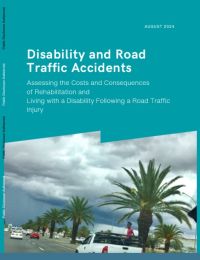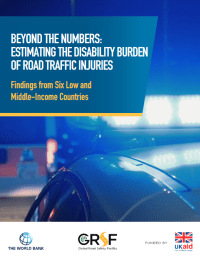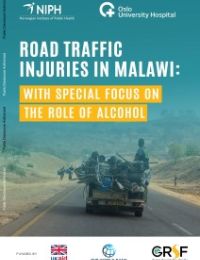Publications
1-3 of 3
-
-
Post-Crash Health Care
Beyond the Numbers: Estimating the Disability Burden of Road Traffic Injuries
November 2023
-
Post-Crash Health Care
Road Traffic Injuries in Malawi: With Special Focus on the Role of Alcohol
June 2021
-
Of 1347 eligible patients who were asked to participate during a period of about three months, 1259 (93.5 percent) gave informed consent, eight patients were not tested for alcohol and thus excluded, resulting in 1251 patients in the study.
-
The prevalence of alcohol was 30.7 percent among males and only 2.5 percent among females, who represented 19.2% of the total cases. There were minor differences across different age groups, with the highest prevalence of alcohol use among those between 25 and 44 years of age (26-27 percent) and lowest among those 45 years of age and older (19.7 percent).
-
The highest prevalence of alcohol was found among patients with no formal education (33.3 percent) compared to patients with college or university education (22.1 percent) with the lowest prevalence.
-
When comparing the different road users, the highest prevalence of alcohol was found among pedestrians (41.8 percent) while the prevalence among the other road users varied from 19.1 percent (bicycle riders) to 24 percent (motorcycle riders).
-
Patients injured during weekend night crashes, showed the highest prevalence of alcohol (59.6 percent), followed by those injured during weekend evenings (36.8 percent) and weekday nights (35.3 percent).
-
Regarding drinking habits, measured by the AUDIT-C questionnaire, hazardous drinking was more common among males (26 percent) than among females (4.2 percent). Age group 25-34 years had the highest prevalence of positive AUDIT-C test (26 percent).
-
The blood alcohol concentrations (BACs) at the time of injury were estimated by back-calculation for road users who were tested for alcohol within five hours after injury in accordance with forensic medicine practices. An estimated proportion of 15.2% of the injured motor vehicle drivers had BAC at or above 0.08g/dl when the crash occurred.
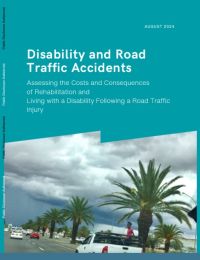
This GRSF-funded study explores the medical, economic, and social costs of road traffic accidents (RTAs), particularly focusing on individuals with permanent disabilities. According to the World Health Organization (WHO), RTAs are a global public health crisis, ranked as the 12th leading cause of death and the primary cause of mortality among children and young adults. While the UN's Decade of Action for Road Safety (2021–2030) aims to reduce RTA deaths, the study argues that more focus is needed on injuries and the long-term impact on those left disabled by RTAs.
Building on GRSF’s report Beyond The Numbers: Estimating the Disability Burden of Road Traffic Injuries (Mitra et al., 2023), this project examines data from Namibia and South Africa and interviews with experts to highlight the often-overlooked challenges faced by RTA-related disability survivors. These individuals encounter unique issues—such as brain injuries, psychological trauma, and sudden financial burdens—that require specific support mechanisms beyond general disability frameworks.
Economic losses from RTAs are substantial, with WHO estimating global costs up to $1.8 trillion annually. However, existing research focuses mainly on medical costs and productivity losses, neglecting broader social impacts. Data on the prevalence of permanent disabilities varies, underscoring the need for standardized research.
The study calls for integrating disability concerns into road safety policies, emphasizing that improved enforcement in low- and middle-income countries could prevent disabilities and reduce societal costs. Ultimately, it advocates for recognizing RTA-related disabilities as a critical issue within global health, disability policy, and development agendas.
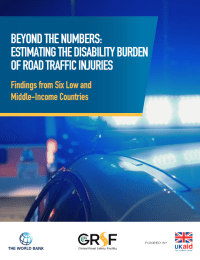
It is well-documented that road crashes claim around 1.35 million lives each year and rank as the eighth leading cause of death globally, causing huge burdens for economies, health systems, and transport networks. However, beneath the sobering fatality statistics lies a largely unexplored landscape: the staggering toll of disabilities induced by road crashes. Until now, the focus of road safety research and policy discourse has predominantly revolved around fatalities, which has limited our understanding of traffic-related injuries and disability burdens at the individual, community, and national level.
To address this critical knowledge gap, this pioneering study—involving over 2,300 patients hospitalized for road crash injuries—provides valuable insights into the prevalence, causes, and long-term impacts of crash-related disabilities. By broadening the discussion beyond fatalities to the often-overlooked issue of disability, the report paves the way for a more holistic perspective on road safety impacts, which can inform more effective road safety policies.
This report is a call to action for comprehensive and context-specific interventions that encompass both the transport and health sectors. Effective measures may include implementing safety regulations, enhancing emergency services, strengthening rehabilitative care, and expanding social safety nets to ease the financial burden on crash survivors. Collaborative efforts between governments, global and regional organizations, civil society, and other stakeholders will be indispensable.
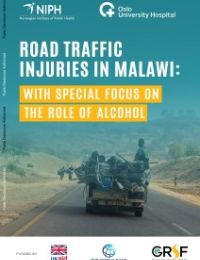
Road traffic crashes are one of the most important causes for physical and psychosocial disease burden and early death worldwide. The United Nations (UN) declared the Decade of Action for Road Safety during the period 2011-2020, with the objective to halve the number of road traffic deaths by 2020. While the number of fatal road traffic crashes has decreased since then in high-income countries (HIC), it has increased in low- and middle-income countries (LMIC). Worldwide, about 90% of the crashes are recorded in LMIC (2016), while these countries had only about 60% of the motor vehicles.
Driving under the influence of alcohol is one of the principal reasons for road traffic crashes. The use of alcohol is also a risk factor for other road users, such as pedestrians and bicyclists. The involvement of alcohol in injurious and fatal road traffic crashes has been well documented in most HICs, but data for LMICs is scarce, particularly for African countries.
The study is a collaborative effort among the Kamuzu Central Hospital (KCH), the Norwegian Institute of Public Health (NIPH) and the Oslo University Hospital (OUH), with the financial support of UK Aid through the Global Road Safety Facility (GRSF), the International Council on Alcohol Drugs and Traffic Safety (ICADTS) and the Norwegian Council for Road Safety (Trygg Trafikk).
The objective of the study was to generate new knowledge about road traffic injuries in Malawi and the extent of traffic accidents related to alcohol use, to increase capacity to conduct alcohol-testing, and develop a database for the findings, which in turn will form the basis for future policymaking to reduce traffic accidents.
The objectives were achieved through collecting data on patients who sought treatment after road traffic crashes and admitted to the Emergency Department at Kamuzu Central Hospital in Lilongwe, Malawi. The data included basic information about the patients, alcohol use before the injury, and information about accident circumstances, including types of road users and vehicles involved. Knowledge and training of local KCH employees to perform alcohol testing and record data were an important aspect of this study.
RESULTS ⌵︎
Acknowledgments ⌵︎
This research project was made possible with the financial support of UK Aid through the Global Road Safety Facility, the International Council on Alcohol Drugs and Traffic Safety and the Norwegian Council for Road Safety.

